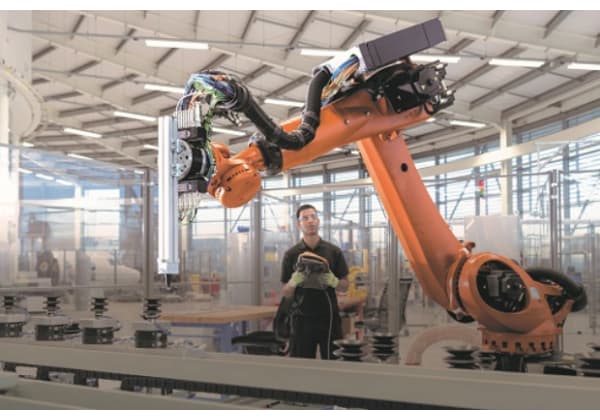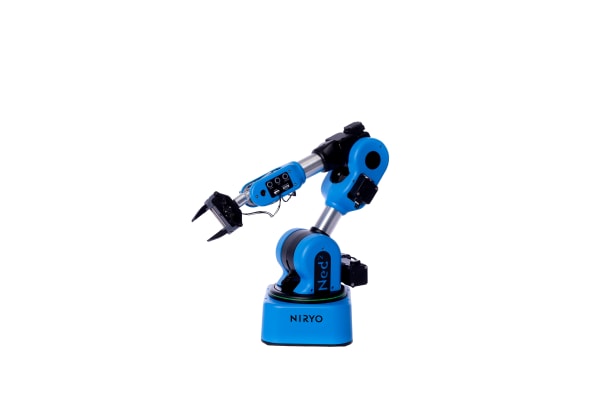- Published 30 Oct 2025
- Last Modified 30 Oct 2025
- 6 min
AI, Data & Robotics Partnership in Modern Industry
Discover how data, AI, and robotics work together in modern industry — from automation to training datasets.

Advancements in large AI models could redefine modern industry through their ability to adapt, interpret, and act upon vastly more complex data, particularly when applied to robotics.
Why Data, AI and Robotics are Converging
While many large AI systems currently operate using visual and language data, the arrival of large-scale multi-modal AI models, which can understand and interpret diverse data types - such as sensor readings, event streams, and structured data - presents many more possibilities within industrial settings.
Robotics is one major area of application. A multi-modal AI agent is the key to building robot brains, allowing them to comprehend their environment more naturally and interact with human users.
The Role of Data in Training Industrial Robotics
Transforming industrial robots from simple programs into intelligent systems relies on huge amounts of good-quality, diverse data.
Data that not only processes the environment through sensors and other hardware but also shows historical decision-making and results.
The machine learning and deep learning algorithms required to allow robots to adapt to new situations and changing environments need to be fed this data to learn from the “experience” it provides.
To realise the projection that Smart Machines could increase UK Gross Value Added (GVA) across sectors from £6.4 billion to a massive £150 billion by 2035, understanding the critical role that high-quality AI data for the robotics industry plays in training these systems will be vital to making this a successful national investment.
How AI Powers Smarter Automation and Decision-Making
The manufacturing sector is experiencing a radical shift in operations as it becomes possible for multimodal AI systems to both navigate complex environments and inform or take decisive action.
There are several areas in which AI systems are revolutionising traditional practices:
Predictive Maintenance
Predictive maintenance is a crucial advancement in reducing the impact of machine downtime.
AI systems that can predict machine degradation, malfunction, and other industrial maintenance requirements, and take decisive action such as ordering new parts or adjusting the schedule of production, have the potential to largely eliminate the lost time and revenue experienced from fixes at the point of failure.
Predictive maintenance relies on multimodal data. This includes:
- Sensors- such as those that might detect overheating or unwanted vibration
- Maintenance records - for historical performance analysis
- Computer vision - for visual inspection
- Natural language processing - to process insights and communicate feedback and recommendations to human colleagues
- Time series processing - to analyse performance patterns and forecast maintenance needs
Today, 95% of adopters report positive return on investment from predictive maintenance technology, and by 2033, the value of this market is predicted to be $91 billion.
Quality Control
AI systems’ machine learning models are essential to analysing real-time data around defects and anomalies that appear, and making key decisions on how to improve products and processes.
Quality control needs technology that can inspect, analyse, and make recommendations. This includes:
- Sensors - to analyse for non-visual defects
- Vision systems (and thermal imaging) - to analyse for visual defects
- Mobile robotics - robot arms, drones, or AMRs to locate or reach the defect
- Machine learning - Learn patterns, detect anomalies
According to McKinsey, AI-powered quality control, and specifically its advanced image recognition technology, has the potential to increase productivity by 50% and defect detection by up to 90% compared with human inspection.
The potential benefit from the industrial application of smart quality control systems is staggering, which consequently, is why 50% of companies plan to focus on AI-powered quality control as their top use of AI machine learning over the next 12 months.
Mobile Robotics
Multi-modal Autonomous Mobile Robots (AMRs) are a huge advancement in warehouse logistics from traditional Automated Guided Vehicles (AGVs), which follow predetermined paths using magnetic spots or laser-guided paths for navigation.
Multimodal AMRs integrate:
- LiDAR (Light Detection and Ranging) - to model the terrain
- Stereoscopic vision (images from two stereo vision cameras) - to improve spatial awareness alongside LiDAR
- Natural Language Processing - for task-based collaboration between robots and humans
- Object detection and recognition - to interact with surroundings
- Real-time decision-making algorithms - to react to the changing factory environment
- Path optimisation - to optimise a route around the factory
Using this information, AMRs can make decisions to optimise their navigation and workflow.
By 2035, it’s predicted that Autonomous Mobile Robots (AMRs) will account for 91% of this robot market, while traditional Autonomous Guided Vehicles (AGVs) will make up just 9%, demonstrating the value of autonomous transportation devices with smarter navigational capabilities.
Real-World Use Cases Across Manufacturing and Engineering
Several companies across the manufacturing, electronics, and aerospace industries are already implementing intelligent robots and systems to make their processes more accurate and efficient:
- BMW uses AI-powered quality control with its inspection technology that detects surface defects in real time
- General Motors employs predictive maintenance systems to forecast equipment failures
- Huawei also uses AI technology for visual inspection of chips, sensors, and high-density PCBs
- Airbus has a strong reputation for advanced maintenance and safety, and its use of drones to assist its maintenance, repair, and overhaul processes is no exception. These devices inspect, detect, and feed back on defect data such as corrosion, cracks, and missing rivets
Challenges in Integration and Data Quality
For the great industrial robot revolution to take off, there are several challenges - spanning technical, operational, and human factors - that organisations need to overcome.
Quality machine-learning data is the first. For systems to achieve their potential, they need access to huge amounts of interpretable data. Not just operational data (quality inspections, maintenance logs, etc) but also environmental data, historic performance information, and sensor data, which provides important real-world context upon which to make decisions.
Highly-skilled engineers will also be required to program, operate, and maintain these systems to ensure they work accurately, optimally, and reliably, particularly in the early stages of implementation.
Data security presents another integration challenge. The interconnected nature of these industrial systems, where real-time information transmission and cloud-based analyses are integral to their core functioning, opens them up to the possibility of cyber attacks.
And finally, the well-known “black box” problem. The complexity of AI workings and the speed of its operations can sometimes create a convoluted decision-making process. To unpick it is essentially too difficult for human operators, and it becomes hard to understand why it has carried out certain operations. The ability to trace decisions in manufacturing is paramount, and a gap in understanding at any stage of adoption can undermine the technology.
What This Partnership Means for the Future of Industry
AI, data, and advanced robotics have the power to fundamentally change industry. The potential far exceeds automation; the future of AI-powered systems lies with their ability to achieve real-time, adaptive decision-making based on multi-modal data from changing industrial environments.
Their ability to comprehend data at vast scale and speeds, optimise processes, inspect for defects, self-navigate, and forecast potential issues makes their industrial application a fundamental necessity to remaining competitive in the global marketplace. In fact, 92% of executives now see smart manufacturing as the main driver of competitiveness. This has increased from 86% in 2019.
In terms of human-AI collaboration, it could both outpace the diagnostic abilities of human colleagues and complement their human insight, expanding what’s possible from a blended workforce.
The strategic importance of this shift in how industry operates is massive. AI systems will make diagnoses and decisions faster, more accurate, and in certain environments, much safer for human colleagues. Multimodal AI is the technological foundation for this transformation.
The market conditions are also ripe for this shift. According to CitiFirst, prices for certain robot types will have dropped by as much as 60% between 2021 and 2027.
AI adoption is also unstoppable, as organisations race to adapt to its capabilities to avoid being left behind. According to Arxiv, AI adoption in the manufacturing sector has grown from 6% to 13.3% among German companies.
The Industrial Internet of Things (IIoT) will also make the widespread connectivity required to converge AI, data, and robotics a much sooner reality, with the market projected to grow from $475 billion to $3.179 trillion by 2034.
The conditions are undoubtedly perfect to accelerate this revolution. Manufacturers who successfully integrate multimodal AI and machine learning into their processes will gain a competitive advantage in terms of operational and decision-making efficiency, accuracy, and adaptability.
Related Articles
Related links
- How AI Data Centres Improve Operations
- Digilent MCC USB-TEMP-AI Data Acquisition USB 24 bits
- Robotics and Process Automation for Industry
- Automation and Robotics in Construction
- Infineon Gate Drivers | RS
- Trends in Smart Automotive Manufacturing
- Making the IIoT work for your business
- The Future of Industrial Robotics


